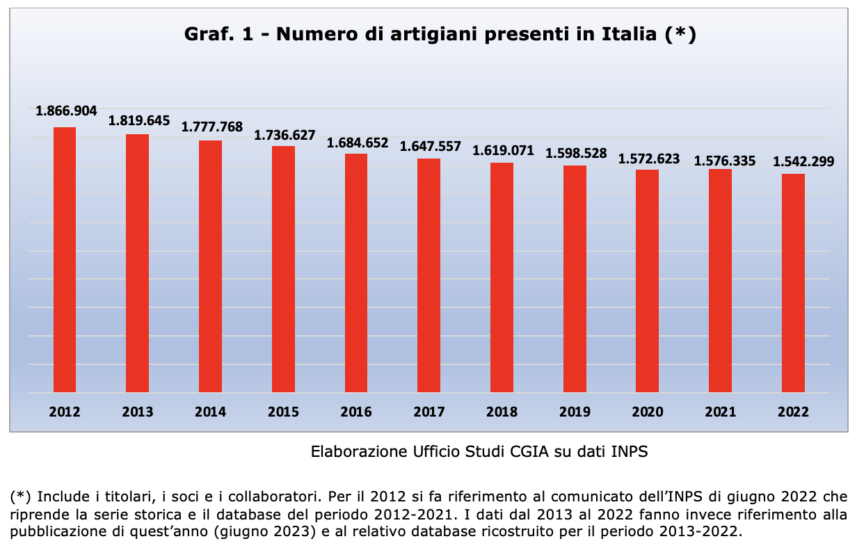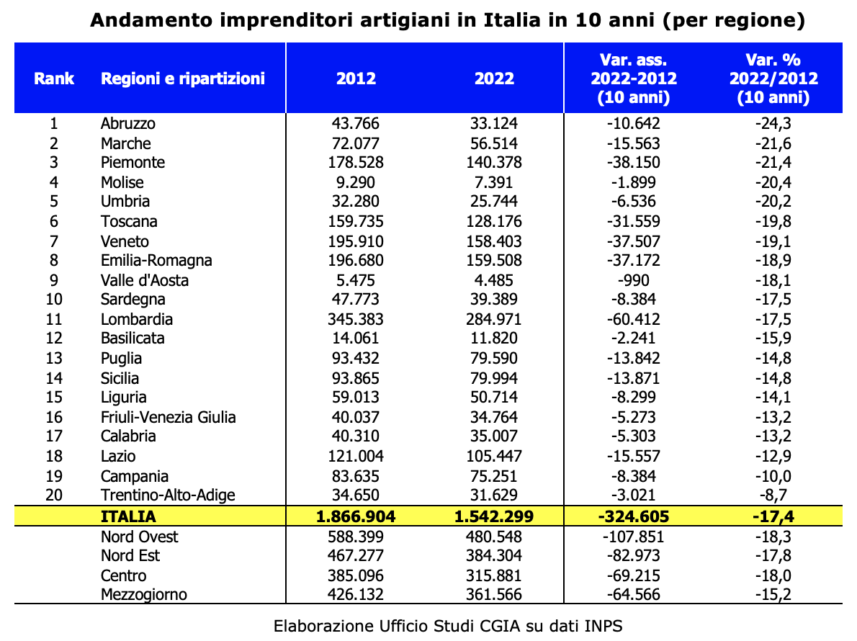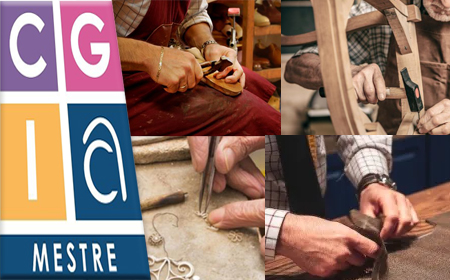Many close down and start working as employees. Young people, on the other hand, don't come any closer
The number of artisans present in Italy continues to decrease. Since 2012 they have fallen by almost 325 thousand units (-17,4 percent) and in the last 10 years only in 2021 has the overall audience increased, albeit slightly, compared to the previous year. According to the latest data made available by INPS, in 2022 we had 1.542.299 artisans [we are talking about natural persons and not companies. In other words, this number includes the owners, partners and family collaborators who are registered with INPS in the artisan category].

We can therefore state that not only young people are less and less interested in working in this sector, but also those who have practiced the profession for many years and have not yet reached the legal age and/or accrued the years of contributions to benefit from the pension, often prefers to close the VAT number and continue to remain in the labor market as an employee who, compared to a craftsman, certainly has fewer worries and more security. The analysis was conducted by the CGIA Research Office.
Without shops, family businesses die out
Going around our cities and provincial towns, many craft activities are now on the verge of extinction. In short, not only is the number of craftsmen decreasing, but the urban landscape is also changing. The artisan shops that host shoemakers, framers, blacksmiths, carpenters, photographers, dry cleaners, watchmakers, leather goods, appliance and TV repairers, tailors, upholsterers, etc. are now reduced to a flicker. Activities, in the vast majority of cases family-run, which have marked the history of many neighborhoods, squares and streets of our cities, becoming points of reference that gave an identity to the places in which they operated. On the other hand, however, the artisan sectors that are experiencing a phase of expansion are those of well-being and information technology. In the former, for example, a constant increase in hairdressers, beauticians and tattoo artists continues to be recorded. In the second, however, there is a marked expansion of system analysts, web marketing workers, video makers and social media experts. Unfortunately, the increase in these activities is insufficient to compensate for the number of closures present in the historical craftsmanship, with the result, as we said above, that the number of artisans is constantly decreasing.
With shutters down, more insecure cities
It is enough to carefully observe the suburban neighborhoods and historic centers to realize that there are many signs that have been removed and just as many are the shop windows that are no longer set up, perpetually dirty and with the shutters down. They are an unequivocal sign of the deterioration of the quality of life in many urban realities. Cities, in fact, are not made up only of squares, monuments, buildings and asphalt strips, but also of places where people meet just to have a chat. These micro-activities preserve the identity of a community and are an extraordinary safeguard capable of strengthening the social cohesion of a territory. In short, with fewer shops and neighborhood shops, the places for socializing on a human scale decrease and everything turns gray, making the urban areas that suffer from these closures less livable and more insecure, penalizing above all the elderly. An increasingly large audience of the Italian population which counts more than 10 million over 70s. Often not having a car and without shops next door, for many of them, shopping has become a big problem.
The causes of the collapse
The strong increase in the average age, caused in particular by an insufficient generational turnover, the fierce competition exercised by large-scale retailers and in recent years also by electronic commerce, the boom in the cost of rents and national/local taxes have pushed many artisans to throw in the towel. Consumers have also changed the way they shop. For some decades they have embraced the throw-away culture, they prefer mass-produced products delivered to their homes. Made-to-measure footwear, clothes or furniture are now an old memory; the hand-made product has been ousted from the purchase chosen on the online catalog or taken from the shelf of a department store.
We need to re-evaluate manual work culturally
There has been a frightening cultural devaluation of manual labor over the past 40 years. Craftsmanship has been "painted" as a residual world, destined to decline and to regain the role it deserves it needs robust investments in scholastic orientation and in the alternation between school and work, putting the training project at the center the professional institutes which in the past have been instrumental in favoring the country's economic development. Today, however, they are perceived by public opinion as second-class schools. For some, in fact, they represent a solution to park kids who don't have a great aptitude for study for a few years. For others they constitute the last chance to allow those pupils who come from scholastic failures, gained in high schools or technical schools, to obtain a high school diploma.
And despite the crisis and the general problems gripping craftsmanship, there are quite a few entrepreneurs in this sector who have for some time been reporting the difficulty in finding personnel willing to approach this world. Throughout the country, it is difficult to find young people willing to be drivers, car repairers, tailors, confectioners, bakers, hairdressers, beauticians, plumbers, electricians, boiler maintainers, turners on the labor market , the millers, the varnishers and the sheet metal beaters. Not to mention that in the construction world it is increasingly difficult to find carpenters, installers and tinsmiths. More generally, however, the craftsman of tomorrow will be the one who will win the challenge of technology to revive even the "old knowledge". At the basis of everything, however, will remain the know-how which is the real engine of our manufacturing excellence.
In Vercelli, Teramo Lucca and Rovigo the decreases in percentage terms are higher
In the last decade, Vercelli and Teramo were the provinces which, both with -27,2 per cent, recorded the highest negative variation in Italy. Lucca follows with -27, Rovigo with -26,3 and Massa-Carrara with -25,3 percent. The realities that, on the other hand, suffered the smallest declines were Trieste with -3,2, Naples with -2,7 and, lastly, Bolzano with -2,3 per cent. In absolute terms, the provinces that recorded the most important "losses" were Bergamo with -8.441, Brescia with -8.735, Verona with -8.891, Rome with -8.988, Milan with -15.991 and, in particular, Turin with -18.075 craftsmen. Lastly, as regards the regions, the most marked decreases in percentage terms concerned Piedmont with -21,4%, Marche with -21,6 and Abruzzo with -24,3 per cent. In absolute value, however, the most significant losses concerned Emilia Romagna (-37.172), Veneto (-37.507), Piedmont (-38.150) and, above all, Lombardy (-60.412 units).

